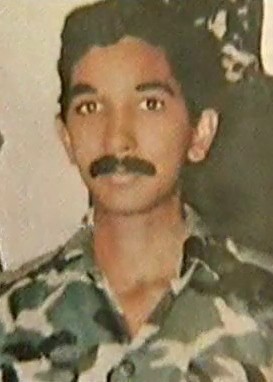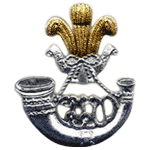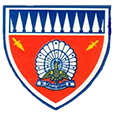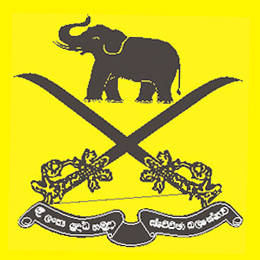The Ceylon Defence Force (CDF) was established in 1910 by the Ceylonese legislation Ceylon Defence Force Ordinance, which reformed the Ceylon Volunteer Force (CVF) that existed previously as the military reserve in the British Crown colony of Ceylon. At the time of forming it was only a reserve force but soon developed into a regular force responsible for the defence of Ceylon. The CDF was under the command of the General Officer Commanding, Ceylon of the British Army in Ceylon if mobilised. However mobilisation could be carried out only under orders from the Governor.

The Sri Lanka Army is the oldest and largest of the Sri Lanka Armed Forces. The army was officially established as the Ceylon Army in 1949, though the army traces its roots back in 1881 when Ceylon Light Infantry Volunteers was created; the army was renamed as the 'Sri Lanka Army' when Sri Lanka became a republic in 1972. In 2024, the Army had approximately 150,000 personnel.

Captain Samarakoon Wasala Mudiyanselage Saliya Upul Aladeniya, PWV, SLRS was a Sri Lankan soldier and the second recipient of the Parama Weera Vibhushanaya, Sri Lanka's highest wartime award for valor. He was commanding the small army detachment at Kokavil; when it was surrounded he refused to abandon the injured and fought until they were overrun by the Liberation Tigers of Tamil Eelam (LTTE).

The Sri Lanka Armoured Corps (SLAC) provides the armour capability of the Sri Lanka Army, with vehicles such as the T-55AM2 main battle tank; the BMP infantry fighting vehicle; and the BTR-80 and WZ551 armoured personnel carriers. It comprises five regular armoured regiments, a volunteer regiment, and a regimental band. It has an independent Armoured Brigade and is headquartered at Rock House Army Camp, Colombo.

The Sri Lanka Artillery (SLA) is the artillery arm of the Sri Lanka Army. It is made up of ten regular regiments and two volunteer regiments. The SLA is headquartered at Panagoda Cantonment, Panagoda.
The Corp of Sri Lanka Engineers (SLE) is a combat support arm of the Sri Lanka Army which provides military engineering. It is made up of ten regular regiments and one volunteer regiment. Headquartered at Panagoda Cantonment, it is headed by the Centre Commandant.
The Sri Lanka Signals Corps (SLSC) is a combat support corps of the Sri Lanka Army, responsible for providing military communications, information technology and electronic warfare support. The corps is made up of a signals brigade, ten regular regiments and one volunteer regiment. It is responsible for installing, maintaining and operating all types of telecommunications equipment and information systems. It is headquartered at the Panagoda Cantonment.

The Sri Lanka Light Infantry (SLLI) is the oldest regiment in the Sri Lanka Army and the oldest infantry regiment in the army. It is made up of sixteen regular battalions and nine volunteer battalions, and is headquartered at the Panagoda Cantonment, Panagoda.

The Gemunu Watch (GW) ("King Dutugemunu's Own") is a infantry regiment of the Sri Lanka Army, formed with troops from the Ceylon Light Infantry and the Ceylon Sinha Regiment in 1962. It has been deployed in many major operations against the LTTE. It is made up of 14 regular units and 9 volunteer units. Headquartered at Kuruwita Army Camp, Ratnapura. It is named after one of the most famous Lankan Kings, King Dutugemunu.

The Sri Lanka Army Volunteer Force (SLAVF) is the active-duty volunteer reserve force of the Sri Lanka Army. The SLAVF is separate from the Regular Force which consists of personal who are professional soldiers and its Regular Reserve, which comprises personal who have a mobilization obligation following their service in the regular army. The SLAVF consists of the volunteer force and the volunteer reserve; administration and recruitment of reserve personal is carried out by the Volunteer Force Headquarters in Shalawa, Kosgama which is headed by the Commandant of the Volunteer Force. It has a current strength of about 55,000 personnel. The SLAVF was known as the Ceylon Volunteer Force from 1949 to 1972 and the Sri Lanka Volunteer Force from 1972 to 1985.
Ceylon Mounted Rifles was the only cavalry regiment attached to the Ceylon Defence Force which was the predecessor to the Sri Lanka Army prior to 1949 when the Ceylon Army was formed. It was a volunteer (reserve) regiment was based in Colombo made up of only of British.
The Sri Lanka Rifle Corps (SLRC) is a (reserve) regiment of the Sri Lanka Army. It is made up of two volunteer (reserve) battalions. It has been formed with personnel from the central highlands and the many plantations in the Central Province of Sri Lanka. It is the only regiment of the Sri Lanka Army that recruits its personnel from a particular geographical area.
The Rajarata Rifles was a former rifle regiment of the Sri Lanka Army. It was one of only three geographically based regiments in the Sri Lanka army. The cap badge of the Raja Rata Rifles show the figure of a Bherunda Pakshiya.

The Sri Lanka Army Medical Corps (SLAMC) (Sinhala: ශ්රී ලංකා යුද හමුදා වෛද්ය බලකාය Shri Lanka Yuddha Hamuda Vayidya Balakaya) is a specialist corps in the Sri Lanka Army which specializes in military medicine and provides medical services to all army personnel and their families in war and in peace. It is made up of 4 regular units and one volunteer unit. Headquartered in Colombo, formally at army headquarters. The corps Cap badge depicting the Rod of Asclepius. General officers and senior officers of the SLMC wear gorget patches of maroon rather than of scarlet worn by other officers of similar rank.
Colonel Thomas Yates Wright, MBE, VD (1869–1964) was a British planter, who was a cricketer and legislator in Ceylon. He was a tea planter and served in the Legislative Council of Ceylon and the Senate of Ceylon.

General L. D. E. Cecil Waidyaratne, VSV, USP was a Sri Lanka Army general. He was 12th Commander of the Sri Lankan Army and a former Sri Lankan Ambassador to Thailand.

Colonel Candauda Arachchige Dharmapala, OBE, ED was Sri Lankan politician. He was a Parliamentary Secretary to the Minister of Industries, Housing and Social Services and Member of Parliament for Hakmana. He also served as the permanent secretary to the Ministry of Defence, and as Security Adviser to President J. R. Jayewardene.
Colonel Sooriyaratne Douglas Ratwatte, ED was a Sri Lankan army officer. He was the Commandant of the Volunteer Force.
Brigadier Leonard "Lyn" Merlyn Wickramasuriya was a Sri Lanka Army officer, he served as the Commandant, Army Training Centre and Diyatalawa Garrison Commander.
Colonel Alan Tollence Nugawela (19??-2007) was a Sri Lankan army officer and a planter.










